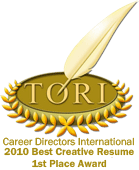
Experience is the heart of your resume, and accomplishments are the heart of your experience.
The experience section is the heart of your resume. It gives hiring authorities evidence that you are the best qualified candidate for the job.
For most candidates, the experience section is placed immediately after the summary section. Exceptions who should place the education section right after the summary include:
- Recent graduates without much relevant work experience.
- Academics or technicians whose educational background is the most important element of their resume.
In your resume, accomplishments are the heart of the experience section. The aim of the experience section is to showcase these relevant accomplishments. Notice I didn’t say complete work history. Your resume isn’t a legal document in the sense that you must include every detail of every position you’ve ever held. (It IS a legal document in the sense that if you’re caught lying on it, you’ll likely lose your job.)
The difficult part about writing the experience section is knowing which and how much information to include. A rule of thumb is to outline three accomplishments for your most recent position. One major accomplishment is enough for earlier positions.
Here is how your experience section should look:
Company Name, City, State Month Year to Month Year (tabbed to the right margin)
Company Description: Tell what the company does and give an idea of its size, usually with the number of employees and most recent annual revenue.
Your Title
Three lines or less explaining what you do.
- Accomplishment 1: Use the challenge, action, result format to write your accomplishment. For example: (Challenge) Sales team quota had gone unmet for 6 months. (Action) Developed and implemented sales training program. (Results) Sales team exceeded quota next 5 months in a row.
- Accomplishment 2: (Challenge) (Action) (Results)
- Accomplishment 3: (Challenge) (Action) (Results)
Some cautions:
- Use the correct company name, not the one you use when chatting about the company. If the company typically uses an acronym, spell out the company name and put the acronym in parentheses after the name: Recreational Equipment, Inc. (REI).
- Be exact with dates. Employers forgive employment gaps of several months. They don’t forgive lying on your resume. Hint: Fudging on dates is lying on your resume.
- Make sure your title is your title. Look on your personnel file if you’re in doubt. Business Development isn’t a title. Sales isn’t a title. Sales Associate is a title. Sales Representative is a title. Sales Manager is a title.
- List date ranges for each position if you have held more than one at the company. Your title line will then look like this:
Your Title (Month Year to Month Year)
- Use only three lines to summarize your job. Don’t write out a list of duties and responsibilities.
- List accomplishments. Don’t list duties and responsibilities here, either. The hiring manager already has a job description. They don’t need to know what you did; they need to know how well you did it. Your accomplishments will differentiate you from other candidates who simply list their skills and duties.
- Use bullets. Long, unbroken paragraphs of text are intimidating to readers. If you break up the page into little chunks (like bullet lists), the reader has an easier time navigating the page.
Next week, we’ll cover the Education section of your resume.
If writing your resume has been holding up your job search, now is the time to schedule some time to talk with me about your career plans.
Image courtesy Stuart Miles via freedigitalphotos.net








